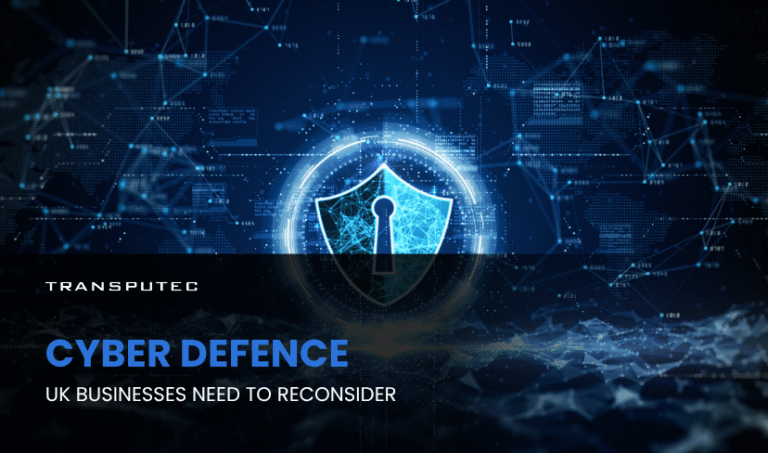Written by CYBERSECURITY SPECIALIST | TRANSPUTEC
Let’s be honest cybersecurity for SMEs isn’t just an “IT issue” anymore. It’s a business risk.
When a single phishing email can halt operations, drain your cash flow, and damage client trust overnight, you’re not just defending systems, you’re defending survival.
Yet, many UK SMEs still think cybersecurity is something they can “sort later” or cover with antivirus software and an occasional password update. In 2025, that mindset is dangerous. Attackers are faster, AI tools are smarter, and the financial impact of a breach can cripple even the healthiest business.
This blog breaks down the top cybersecurity threats UK SMEs must be ready for and, more importantly, how to defend with the right strategy and the right managed services partner.
Why Is Defending Against These Threats So Hard for SMEs?
SMEs face three recurring challenges:
- Limited resources: You can’t justify a full-time cybersecurity team.
- Complexity: The tools, alerts, and compliance requirements are overwhelming.
- Reactive culture: Many SMEs only act after an incident.
The irony? These same factors make SMEs the easiest targets and the slowest to recover.
Cybersecurity isn’t about doing everything. It’s about doing the right things consistently and that’s where a managed services partner like Transputec changes the game.
What Are the Top Cybersecurity Threats UK SMEs Face in 2025?
The threat landscape in 2025 looks very different from even two years ago.
AI-powered attacks, supply chain vulnerabilities, and remote workforce risks have changed the game.
Here’s what you’re up against:
1. AI-Driven Phishing and Deepfake Attacks
Forget misspelled Nigerian princes. Phishing has evolved.
In 2025, attackers use AI to mimic real executives, copy your writing style, and send ultra-convincing requests for payment or data. Deepfake voice scams are on the rise too, imagine receiving a voicemail that sounds exactly like your CEO asking you to approve an urgent transfer.
Stat to note: 92% of UK data breaches in 2024 involved human error or social engineering.¹
2. Ransomware-as-a-Service (RaaS)
You no longer need to be a hacker to run ransomware, you can subscribe to it.
Criminal groups now sell ready-made ransomware kits online, meaning SMEs are increasingly targeted because they’re seen as low-hanging fruit: easier to breach, faster to pay.
Average ransom demanded from UK SMEs in 2024: £110,000.
3. Supply Chain & Vendor Vulnerabilities
Your cybersecurity is only as strong as your weakest supplier.
Attackers often target small vendors with poor controls, using them as an entry point to your systems or client data. In regulated sectors, like finance, healthcare, or legal, this isn’t just bad news, it’s a compliance nightmare.
4. Insider Threats & Human Error
It’s rarely malicious. More often, it’s an employee clicking a fake link, sharing credentials, or uploading data to an unsecured drive. In hybrid work environments, shadow IT, employees using unsanctioned tools is quietly growing risk exposure.
5. Cloud Misconfiguration
As SMEs move more systems to the cloud, configuration mistakes (like open S3 buckets or weak access controls) expose sensitive data. Cloud is powerful, but misconfigured cloud is a hacker’s dream.
What’s at Stake for UK SMEs?
When you’re scaling, every hour of downtime, every client call about “a data issue,” every compliance headache eats into your growth momentum.
Here’s what’s truly at stake:
- Operational disruption: Downtime from ransomware can stall logistics, payments, or production for days.
- Financial loss: Fines under GDPR, ransom payments, or client compensation can easily exceed six figures.
- Reputation damage: Losing client trust can take years to rebuild.
- Compliance risk: Especially if you handle customer or financial data.
- Investor confidence: Cyber resilience is now a due-diligence factor for investors and acquirers.
Cybersecurity isn’t about avoiding loss, it’s about protecting agility and growth.
How Do These Threats Work in Practice?
Let’s walk through what a real-world SME breach looks like.
Imagine you’re a 50-person logistics firm. A senior finance manager receives an email from your supplier or so it seems. The sender’s name, tone, and logo all check out. The email asks for a “quick invoice review,” linking to a familiar-looking site.
She logs in. Nothing happens.
Hours later, your system is encrypted. Your files are locked. Your operations halt.
And you’re staring at a ransom note asking for £80,000 in Bitcoin.
This is how cybersecurity threats UK SMEs face in 2025 play out fast, silent, and devastating.
Without an incident response plan or managed service partner on standby, recovery can take weeks.
Who’s Most at Risk?
While every business is a target, some sectors are hit harder:
- Finance & professional services: Sensitive data and regulatory pressure make them prime targets.
- Healthcare & social care: Legacy systems and human-driven operations expose weak links.
- Manufacturing & logistics: Ransomware attacks can freeze production lines.
- Retail & eCommerce: Payment data and customer info attract cybercriminals.
- High-growth startups: Rapid scaling often means security lags behind infrastructure.
If your team handles personal data, uses cloud systems, or depends on uptime you’re already in the risk zone.
How a Managed Services Partner Helps Defend Your Busines?
Partnering with a managed service provider (MSP) like Transputec isn’t just outsourcing IT — it’s bringing in a business enabler focused on resilience and ROI.
Here’s how the right MSP protects you:
1. 24/7 Threat Monitoring & Rapid Response
Cyber incidents don’t wait for office hours. Our Security Operations Centre (SOC) monitors systems round the clock, detecting and isolating suspicious activity before it spreads.
2. AI-Enhanced Detection and Prevention
Transputec leverages advanced analytics to identify patterns that traditional tools miss spotting anomalies early and automatically neutralising risks.
3. Employee Awareness Training
Your people are your first line of defence. We help you build a security-first culture through simulated phishing, regular training, and automated reminders.
4. Data Backup and Recovery
We ensure encrypted backups, off-site replication, and tested recovery plans so even if ransomware hits, you recover fast.
5. Compliance & Risk Governance
Whether you face ISO 27001, GDPR, or FCA compliance requirements, we streamline reporting and governance turning compliance into confidence.
6. Tailored Cybersecurity Strategy
No copy-paste packages. We align security with your business goals whether you’re scaling a startup or protecting critical infrastructure.
“Transputec helps SMEs turn cybersecurity from a cost centre into a growth enabler.”
What You Need to Know to Stay Ahead?
AI attacks will grow — assume phishing is indistinguishable from real messages.
Zero Trust is becoming standard. Verify every access request.
Regulation is tightening — especially for supply chain security.
Cyber insurance now requires proof of robust controls.
Managed service models will dominate SME cybersecurity due to affordability and access to expertise.
Conclusion
The top cybersecurity threats UK SMEs face in 2025 aren’t abstract — they’re real, growing, and business-critical. From AI-driven scams to ransomware and insider risks, the cost of inaction is far higher than prevention.
Partnering with an experienced managed services provider like Transputec transforms cybersecurity from a technical headache into a business advantage protecting your data, your operations, and your growth trajectory.
Don’t wait for a breach to find your weak spot. Book a cybersecurity consultation with Transputec and discover how we can secure your business while you focus on growth.

Secure Your Business!
Ready to explore how we can enhance your security posture? Contact us today to speak with one of our experts.
FAQs
What are the top cybersecurity threats UK SMEs face in 2025?
The biggest risks include AI-powered phishing, ransomware-as-a-service, supply chain breaches, insider threats, and cloud misconfigurations. Each targets SMEs due to weaker defences and higher potential payoff.
Why are UK SMEs such attractive targets for cybercriminals?
SMEs often lack in-house security expertise, rely on outdated systems, and underestimate risk. Attackers know this, so they focus on easier entry points, like staff emails or unpatched software.
How can a managed services partner help protect my SME?
A partner like Transputec provides 24/7 monitoring, AI threat detection, compliance management, and proactive defence, delivering enterprise-level protection without enterprise-level costs.
What’s the cost of a cyberattack on an SME?
According to UK government data, the average cost of a breach for SMEs is over £19,400, excluding downtime and reputational loss. For many small firms, a single incident can threaten survival.
What should I do first to strengthen cybersecurity in my SME?
Start with an audit. Identify your weakest links usually people and outdated systems. Then implement multi-factor authentication, regular backups, and employee training. Partnering with an MSP ensures these defences stay updated and aligned with new threats.




